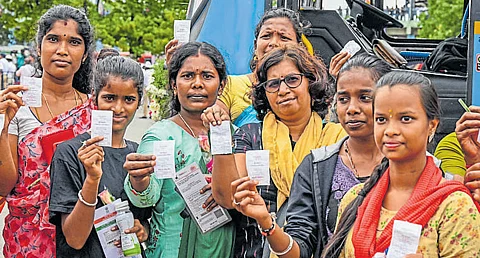

DH PHOTO
Women save 30-50 per cent on transport costs in cities with fare-free travel, allowing them to redirect resources towards essential household needs such as food, healthcare and children's education, according to a survey covering five states in the country.
Fare subsidies for bus travel also lead to more jobs for women, it said.
More than one in four women across Delhi, Bengaluru and Hubballi-Dharwad, where fully subsidised fare is in place, reported switching to buses after such schemes were introduced, the study said.
The report – 'Beyond Free Rides: A Multi-State Assessment of Women's Bus Fare Subsidy Schemes in Urban India' -- commissioned by the Sustainable Mobility Network and prepared by Nikore Associates, evaluates such fare subsidy programmes for women and transgender persons across 10 cities in Delhi, Karnataka, Kerala, West Bengal and Maharashtra.
"For many women, especially those in low-income jobs, daily bus fares stood in the way of work and opportunity. Removing that cost does more than improve access -- it enables economic participation and affirms dignity," Nikore Associates founder and chief economist Mitali Nikore said in a statement.
"In cities with a full bus fare subsidy scheme, women save consistently over half of their monthly transport expenses. These savings offer meaningful budget relief, allowing them to redirect resources toward essential household needs such as food, healthcare and children's education," the report said.
Cities with partial subsidy schemes offer limited financial benefits, it said.
The report revealed that in cities such as Nagpur and Pune, where fare subsidies apply primarily to intercity or long-distance routes, average monthly savings range from Rs 409 to Rs 538.
These limited outcomes are due to a "misalignment between subsidy coverage and women's actual travel patterns, as most of their trips occur within the city limits and are linked to work-related responsibilities", it said.
These daily, short-distance journeys often remain fully paid by the women, which limits the overall effectiveness of the subsidy, the report found.
Survey data reveals that women in cities with reliable service delivery, such as Bengaluru, where bus availability and frequency are strong, report employment improvements at rates almost five times higher than those in cities with infrastructural constraints.